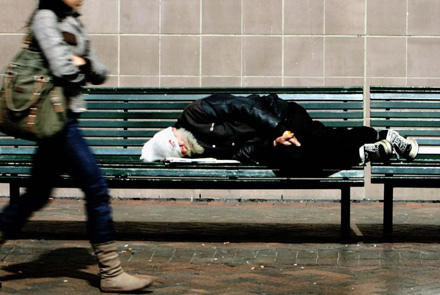
The links between homelessness and trauma are explored in a new report to be launched on 15 December 2010 in Sydney.
Learn to listen and know that it is very hard to
have no home and expect you to remember a lot of rules when you are
traumatised. – Anonymous homeless person, in response to being asked how homeless services
could be improved.
Homelessness and
trauma
Last year, the Public Interest Advocacy Centre commissioned a social researcher from the University of Technology, Sydney (UTS), Dr Catherine Robinson, to research the experiences of violence among people who are currently rough sleeping.
Dr Robinson’s report, to be launched next week, is titled Rough Living: Surviving violence and homelessness. It adopts a ‘life-history’ approach, using interviews with 12 individuals currently sleeping
rough in the Sydney region. The interviewees speak about their experiences of violence prior to and
during their periods of homelessness.
During the course of the research, the enduring impacts of
childhood abuse and trauma became apparent.
Of those who participated in the
project:
- Eight
participants described childhoods marked by their parents’ relationship
breakdowns and separation, addiction, mental illness, housing instability, and
inability and unwillingness to care for their children.
- Seven
participants reported witnessing their parents’ domestic violence and five were
also exposed to the physical and sexual abuse of their siblings.
- Eleven participants reported childhood sexual and physical abuse perpetrated mostly by
parents and step-parents but also by siblings. This included sexual abuse, physical torture, physical
violence with weapons, physical bashings by punching, slapping and kicking, and
neglect.
- Sexual
and physical abuse was accompanied by emotional abuse which usually revolved
around participants being told they were useless or unwanted, being threatened
with further harm, including murder, and receiving punishment if they
questioned abuse or revealed abuse outside the family.
The report found considerable links between homelessness,
child-abuse and trauma.
These findings are confirmed by other research that
reveals extremely high rates of childhood sexual, emotional and physical abuse
experienced by those who become homeless.
Research has shown that over 70% of
young homeless women and 30% of young homeless men can be expected to be
survivors of sexual abuse, while 70% of young homeless men and 30% of young
homeless women can be expected to be survivors of physical abuse. The number of
people experiencing childhood emotional abuse remains harder to quantify.1
Impacts of trauma
There needs to be a radical shift in the thinking of people who
work with vulnerable groups such as homeless people. Abuse that is suffered as
a child is not simply a childhood issue. The resultant trauma from childhood
sexual, physical and emotional abuse informs the majority of the individual’s
interactions into adulthood.
Service providers need to be willing to recognise that a different
approach is necessary and to start to examine different practices in service
delivery. These changes need to occur at both the point of service contact with
homeless people and in service management and development.
Trauma produces certain behaviours and symptoms that can vary in
severity. Some of the symptoms and behaviours can include nightmares,
dissociation, anxiety, panic or aggressive responses and self-destructive
behaviours such as self-harm.
Impacts of service
provision
The large number of people experiencing homelessness and trauma
means that all services working with this population must have an understanding
of trauma and its impact on the individual. This understanding must extend
beyond consideration of the kinds of programs that should be provided, into
service design and administration.
The participants in Rough Living provided specific detail on how a whole range of services
(including specialist homeless services) did not understand nor seek to address
the trauma they were experiencing. Participants noted how they felt silenced by service providers in the face of a desperate need to
have these experiences recognised and to be assisted to access avenues through
which to heal themselves.
When services fail to consider the impacts of trauma on the
individual clients, they not only fail to assist with their healing but can
also become complicit in their re-traumatisation. People re-experience trauma not only when they are forced to
tell their stories (often over and over again), but frequently in the ways they
are treated by the staff of service providers.
For example, speaking in aggressive, confronting or challenging
tones is likely to have particular impacts on someone who has experienced
emotional or physical abuse.
What next?
In response to Rough
Living, PIAC, through the Homeless Persons’ Legal Service*, has formed a
working party to specifically address the lack of knowledge about trauma and
trauma-informed service delivery.
In order to provide assistance and professional advice,
instructions for working with clients experiencing trauma and trauma informed
care, HPLS and the working party are hoping to develop a trauma-based training
package. The working group hopes
to be able to offer assistance with service design and delivery and practical
on-site assistance for staff.
It is hoped that the outcome of this work will be that people who are
homeless and experience trauma will receive acknowledgment and services that
suit their particular needs.
This story was written by the Homeless Persons’ Legal
Service Policy Officer, Chris Hartley.
Thanks
to Dr Catherine Robinson from UTS for providing research material used to
formulate this article.
HPLS is a joint initiative of the Public Interest Advocacy
Centre and the Public Interest Law Clearing House.
Footnote
1. Lisa
Thrane, Dan Hoyt, Les Whitbeck, and Kevin Yoder, ‘Impact of Family Abuse on
Running Away, Deviance, and Street Victimization among Homeless Rural and Urban
Youth’, (2006) Child
Abuse and Neglect, 30 10, 117
Photo: Flickr/publik16